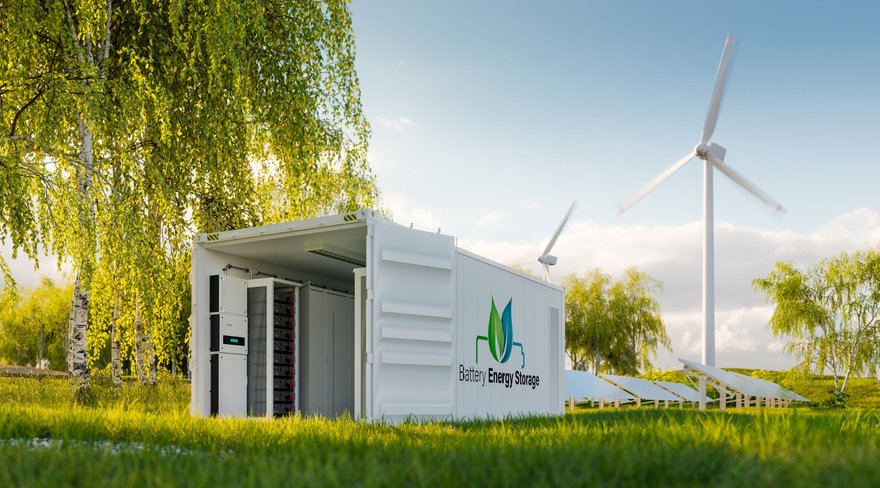Uninterruptible power supplies (UPS) have always been relied on to keep the lights on and provide critical services in the event of a grid outage.
From hospitals to intelligent transport systems all the way to data centers, UPSs are there to keep operations running when a grid failure occurs. When everything else is interrupted, they are there to keep things going.
Most, if not all, data center facilities will make use of a huge set of batteries that are part of the UPS systems, with their total capacity sized to the IT load. Those batteries are likely either lead-acid or more modern lithium-ion ones.
If the data center is built to high availability standards, which make up the majority of modern data centers today, the power stored in their batteries is now at a scale that could be used to help the grid when it struggles, rather than just weather the problem.
This change also promises easier management of sustainability efforts for owners and operators of data center facilities.
When you don’t trust the grid
The opportunity for embracing more advanced UPS systems comes as most governments and utilities replace carbon-intensive energy sources with renewable ones which - while necessary - is impacting the grid.
Whenever a large power plant is brought online, it will cause imbalances in phases and frequency across that electrical grid. This applies equally if a large energy source is decommissioned, and once the intermittency of renewable energy sources is factored in, the grid will experience more and more frequency variations.
If left unchecked, this can lead to outages. User demand can vary massively during different times of the day or year, especially in major weather events, leading to potential grid shortages if not managed well.
The data center business shares the world’s insatiable desire for more energy, and was among the first to support the push for more renewable sources that cut carbon emissions.
As the sector faces a future of unreliable grids, the UPS may prove its worth once again in avoiding calamity.
Criticality and Redundancy of UPS
As we know, the UPS sits at the heart of the electrical distribution system of a data center, providing clean, uninterruptible power to the IT equipment and, along with a power switching mechanism, keeps the IT load alive during the period of switching to an on-site power source, usually in the form of a diesel generator.
For a data center facility, the higher the availability requirement, the higher the battery and generator capacity installed to ensure that the facility keeps the IT load going no matter what.
This often unused capacity, with the right tools, can be made available to the grid in order to help it recover from an outage or outright prevent one. This is currently being explored by the bigger players in the industry through what is known as a grid-interactive UPS.
Talking to the grid
UPS systems within high-availability data centers will have double or sometimes triple the required battery capacity to ensure mission-critical IT loads are never lost. However, this capacity is almost never used up, creating an opportunity.
Through the use of an external controller and a swathe of digital capabilities, data from the grid flows in real-time. When a change in grid frequency occurs, it instructs the UPS to respond with positive and negative regulation by charging or draining the batteries within their operational limitations. This effectively turns the data center’s UPS into a DER - distributed energy resource.
This, in turn, can create a new generation of grid-interactive data centers and potentially shift them from being huge consumers of energy into a critical part of the wider electrical distribution system.
Selling flexibility into the grid allows data centers to monetize underutilized resources by providing energy storage and supplying the fast-frequency response services that grid operators will increasingly require as renewable energy capacity increases and the grid loses the rigidity associated with fossil-fuel power generation.
The benefits
A grid-interactive UPS can help data centers commercialize their stored energy and reduce their overall energy cost, having a positive impact on a facility's Total Cost of Operation (TCO) - which is primarily led by the cost of energy.
This is accomplished through balancing services, which assist demand in meeting grid supply by focusing on quick frequency response and demand control. Balancing services ensure that power supply meets real demand, providing grid stability and enabling income production as well as energy savings.
Further, if the facility takes part in demand management programs with the local grid - also known as “peak shaving” - it can lower its energy consumption by switching to its onsite power generation or relying on the stored capacity in its batteries. Through this mechanism, it helps the grid avoid an outage.
Essentially, grid-balancing data centers earn additional "energy" compensation based on how quickly they respond to frequency fluctuations as well as the quantity of energy saved.
The remaining challenges
With the technology being fairly new, there are few examples of real-world deployments at scale. Change-averse data center operators remain reluctant to change the UPS systems they have relied on so far, which are at the heart of mission-critical operations.
Most concerns revolve around the impact of the lifecycle of the batteries themselves as grid-interactive technologies will charge and discharge the batteries more than is the case now in data center facilities.
Manufacturers stress that these concerns are unfounded as operational limits can be baked into the grid response methodology, allowing the UPS to interact with the grid only when it is safe to do so. Further, modern UPS systems have built-in optimization features and advanced analytics to deal with the main aging factors related to each battery chemistry.
Current deployments
With the technology being relatively new and only fit for some players within this industry, details about existing grid-interactive UPS deployments are scarce.
In July last year, Microsoft, together with Eaton’s EnergyAware UPS, used this technology in a Dublin data center campus. This move stems from the fact that EirGrid, Ireland’s electrical distribution operator now prioritizes non-carbon energy sources and Microsoft is participating through Enel X - an energy services and solutions provider that aggregates industrial and commercial energy consumers into virtual power plants.
While exact numbers are not disclosed, such as battery capacity and how much Microsoft is willing to make available for grid interactivity, the company claims that, over the next couple of years, this move will remove about two million metric tons of carbon dioxide emissions that would otherwise be generated from Ireland’s National Grid.
Telia is also connecting the UPS systems at its 24MW Helsinki data center in Finland to the local grid.
Despite the unknowns, the technology definitely piques the interest of owners and operators of data center facilities, with analyst firm Omdia noting that more than 80 percent of survey respondents will most likely deploy grid-interactive UPSs within the next five years. As usual for this industry, the technology will require more deployments and for it to mature before it becomes the standard way data centers and other mission-critical facilities will be built.
But the energy landscape shows no signs of improving any time soon as more renewable sources come online and demand outstrips supply. As pressure grows, it may become harder to ignore the swathe of benefits that come with grid-interactive UPS technology.


